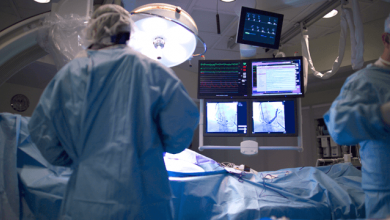Search results
Author(s):
Alexander Steger
,
Daniel Sinnecker
,
Petra Barthel
,
et al
Added:
3 years ago
In 1885, Oscar Langendorff was the first person to describe the increase in contractility (‘Pulsverstärkung‘) that follows an extrasystole.1Langendorff experimented with spontaneously beating isolated frog hearts. He recorded the heartbeats by using a lever that transferred the contractile movements of the heart to a rotating drum. Electrical stimulation resulted in premature contractions that…
View more
Author(s):
Krystien VV Lieve
,
Arthur A Wilde
,
Christian van der Werf
Added:
3 years ago
Catecholaminergic polymorphic ventricular tachycardia (CPVT) is a rare but severe genetic cardiac arrhythmia disorder. Clinically, CPVT most often presents in childhood with symptoms such as syncope or sudden cardiac death due to polymorphic ventricular tachycardia (VT) or ventricular fibrillation typically triggered by exercise or emotions in the absence of structural heart disease.1
Mutations…
View more
Author(s):
David J Sprenkeler
,
Marc A Vos
Added:
3 years ago
The concept of post-extrasystolic potentiation (PESP), which describes the phenomenon of increased contractility of the beat following an extrasystole, has intrigued physiologists and clinicians for more than 120 years. Since its first description in 1885 by Oskar Langendorff,1 PESP has become a widely debated concept, not only for its fundamental basis but also because of the potential…
View more
Author(s):
Cristina E Molina
,
Jordi Heijman
,
Dobromir Dobrev
Added:
3 years ago
Optimal cardiac function depends on appropriate rate and force of contraction, with specific cardiac regions having developed particular beat-to-beat properties depending on their individual functions. For example, isovolumetric contraction time is shorter in the right ventricle (RV) than in the left ventricle (LV). At the cellular level, cardiac function is regulated by regional cardiomyocyte…
View more
Author(s):
Antonio Zaza
,
Carlotta Ronchi
,
Gabriella Malfatto
Added:
3 years ago
The incidence of ventricular arrhythmias is often related, within an individual, to the rate of their underlying sinus rhythm (heart rate). The direction of this relationship is generally considered to entail some prognostic significance: whereas ectopic activity suppressed by tachycardia is assumed to be benign, an arrhythmia enhanced by tachycardia is regarded with more concern. Is this…
View more
Author(s):
Penelope A Boyden
,
Wen Dun
,
Bruno D Stuyvers
Added:
3 years ago
Abnormalities in electrical rhythm were studied by Einthoven at the start of the 20th century. In the 1940s, studies by Bozler et al.1 described contractile signals that appeared to be ‘triggered’ heart beats. Today we use the term delayed afterdepolarisations (DADs) to refer to oscillations in voltage that follow a driven action potential.
In the mid-1970s, progress was made when Lederer and…
View more
Author(s):
Sharon A George
,
N Rokhaya Faye
,
Alejandro Murillo-Berlioz
,
et al
Added:
3 years ago
More than 100years have passed since the atrioventricular node (AVN) was first discovered by Sunao Tawara1 and described as a “Knoten” of tissue located at the proximal end of the Bundle of His (BoH).2 Despite the numerous advances in knowledge regarding the structure and function of the AVN, there are still several controversies that need to be addressed in both clinical and scientific settings…
View more
Author(s):
Nabil El-Sherif
,
Gioia Turitto
,
Mohamed Boutjdir
Added:
3 years ago
Since its initial description by Jervell and Lange-Nielsen in 1957,1 congenital long QT syndrome (LQTS) has been the most investigated cardiac ion channelopathy. A prolonged QT interval on the surface ECG is a surrogate measure of prolonged ventricular action potential duration (APD).
Congenital as well as acquired alterations in certain cardiac ion channels can affect their currents in such a…
View more
Author(s):
Sebastian Clauss
,
Moritz F Sinner
,
Stefan Kääb
,
et al
Added:
3 years ago
Atrial fibrillation (AF) is the most common arrhythmia experienced in clinical practice, and is responsible for significant morbidity and mortality.1 It affects more than 6 million people in Europe.1 The lifetime risk of developing AF after the age of 40 is approximately 25 %.1 AF is a major public health burden as it is associated with an increased risk of stroke by fivefold, dementia by twofold…
View more
Author(s):
Ahmed M Al-Kaisey
,
William Figgett
,
Joshua Hawson
,
et al
Added:
1 year ago











